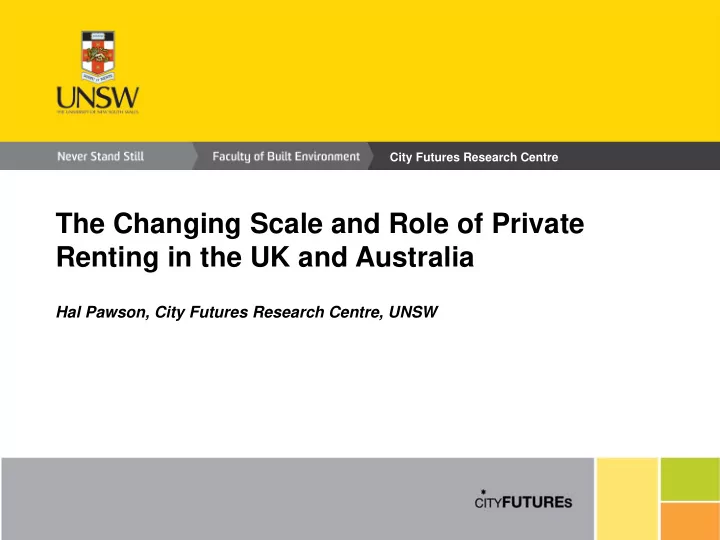

City Futures Research Centre The Changing Scale and Role of Private Renting in the UK and Australia Hal Pawson, City Futures Research Centre, UNSW
Presentation overview Draws on • – Chapter in UK Housing Review 2011/ 12 – review of recent UK research plus original secondary data analysis – Ongoing Australian research led by Kath Hulse and Terry Burke, Swinburne University Covers: • – Comparability of UK and Australia – Sector growth dynamics and geography – Changing role of the PRS – Conclusions and research agendas
The PRS in the UK and Australia: how comparable? Both countries exemplify the ‘liberal model’ • of PRS regulation: No standard expectation for security of tenure – beyond 6 months Market rents – Ownership structures dominated by small- • scale investors Some significant differences - Australian • PRS: set within system where public housing only – 5% stock predominantly houses not flats – no heritage of ex-RTB property – taxation policy settings more favourable than – in UK lacks underpinning equivalent to UK Housing – Benefit system: greater concerns on affordability
Growth dynamics Private renting about to become • predominant in UK – recent growth 9% p.a. With home ownership falling since • 2005, PRS the only expanding housing sector Supply side – weak recovery in BTL • investment 2009-11 but only up to a third of 2007 peak Growing ‘rent not to sell’ component – • 22% of PRS properties in England acquired as landlord’s main home
International PRS scale and growth rate comparison UK PRS still at lower end of • international scale Australia’s PRS continues to expand • but recently at less than half UK rate Recent supply growth due to: • continuing investor activity – investor – lending remains at high levels ‘rent not to sell’ motivations – 29% of – Australia’s rental property owners also renters themselves Common factors recently boosting • demand in both countries: Migration – esp foreign students as well – as migrant workers Flatlining or falling home ownership – Similarity in the increasing predominance • of ‘mum and dad investors’
Geographical growth patterns Excluding London, PRS revival in • England inversely correlated with 1991 scale of provision District level analysis for 1991-2001 • period shows similar pattern Indications of substitution for social • rent In Australia lower rent properties • increasingly concentrated in outer suburbs Polarisation of Melbourne’s inner-outer • area rent differential Recent extra twist through foreign • student demand for inner metropolitan property?
PRS investment targeting Estimated avg value of UK • investor-purchased homes in 2011 - £153k Just below UK all-dwellings house • price norm for 2010 Suggests gross rental rate of • return – 5.4% (9% in 2002) Australian investor activity targeted • further upmarket incentivised by negative gearing rules – tax advantages apparently outweigh – rental rate of return attraction of cheaper properties
Changing role of the PRS (1) Britain’s PRS accommodating a • growing % of every income cohort Now houses 20% of lowest • income cohort PRS therefore ‘playing an enlarged role in housing the poorest’ But proportionate growth larger for • higher income cohorts PRS therefore ‘going upmarket’ No directly comparable Aus data • but by implication, PRS also housing growing % of low income hhs
Changing role of the PRS (2) Growing representation of • family households in England’s PRS – % of all renters up from 22% to 30% – Absolute number more than doubled over 10 years to 2010 Smaller recent increases - % • and absolute - in family households in Australia’s PRS
Changing role of the PRS (3) Growing representation of Percentage of each cohort living in • Australia’s PRS, 1990 - 2009-10 ‘middle age’ cohorts in Australia’s PRS % of 35-44 year olds nearly doubled to 28% from 1990- 2010 Suggests more households • constrained (or choosing) to live in PRS for longer periods Cohort effect may lead to rising • numbers of older renters
Changing role of the PRS (4) Growing number of ‘long term • renters’ in England’s PRS Renters with tenancies >5 • years up by 9% in 10 years to 2010 1 in 6 private renting families • living in PRS for >5 years Figures are underestimates • because reflect duration of current tenancy not time in sector
Conclusions and research agendas Overwhelmingly similar sector dynamics but some contrasts in research agendas reflecting contrasting institutional/policy frameworks... UK Australia Agendas Investor motivations – esp institutional investors * * Rental affordability * PRS suitability for low income/disadvantaged hhs * * Regulation of property condition and management * Consequences of welfare reform * Key sources Census (5-yearly in Aus) * * Rental Bond Board statistics * Valuation Office Agency * Govt-commissioned landlord and tenant surveys * * Tax records *
References Hulse, K., et al (forthcoming 2012) The Australian Private Rental • Sector: Changes and Challenges ; AHURI positioning paper; Melbourne: AHURI Pawson, H. (2012) The changing scale and role of private renting • in the UK housing market; in: Pawson, H. & Wilcox, S. (eds ) UK Housing Review 2011/12 ; Coventry: CIH
Recommend
More recommend